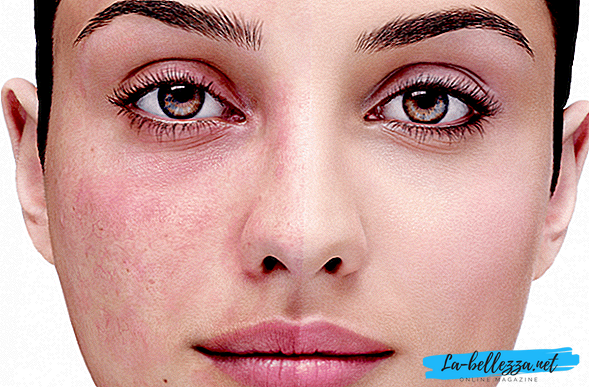
Women and girls often face the problem of sudden redness on their face. This may be a reaction to cosmetics, improper cosmetic care, dermatitis, and many other problems. In order to correctly eliminate such a reaction, it is necessary to find out the reason when visiting a dermatologist. This is necessary to rule out serious diseases.
If the causes of the appearance of redness are not related to the problems of a dermatological nature, then using a quality cream you can not only disguise the redness, but also cure it. The most important thing is to choose the right one that suits your skin type, cream or tonal remedy with a healing effect.
Causes of redness

Redness is the result of accumulation of crowded microscopic blood vessels under the skin. It can be either on the whole face, or in separate zones, for example, near the nose or on the cheeks.
As already mentioned, the causes of redness of the skin is very much. Starting from a simple allergy to household chemicals and ending with serious diseases. In order to start troubleshooting, you need to find out what reason could cause such a reaction.
To the most common causes of facial flushing include the following:
- Hereditary predisposition to skin irritations and the appearance of red spots;
- Thin and light skin and closely spaced network of vessels to the surface (couperose);
- Allergic reactions to both external and internal stimuli. And most often, allergies are accompanied by additional symptoms in the form of itching, edema, or rash;
- Improperly selected cosmetic or hygiene products for skin care of the face;
- Temperature effect. Cold and heat can cause a rush to the blood vessels, which causes redness. Serious forms of redness are burns and frostbite;
- Emotional reactions, anger, embarrassment, stress, etc. also cause temporary redness of the skin;
- Cosmetic procedures, ranging from massage to various peels, injections, etc. cause severe flushing, which can keep from several hours to several days;
- Increase in blood pressure due to illness or bad habits, such as alcohol;
- Increased body temperature in diseases or physical exertion;
- Changes in hormonal levels during pregnancy, menopause or menstruation;
- Dermatological diseases or residual effects of these diseases;
- Diseases and pathologies of internal organs or disorders of the hematopoietic system can also manifest as redness on the face as a signaling symptom.
The recommended composition of the cream against redness

If during a survey with a dermatologist you found out that redness on your face is a reaction to improper cosmetic care, then this problem can be eliminated with the help of a properly selected cream.
A quality cream should eliminate not only the cosmetic defect of hyperemia, but also nourish, moisturize the skin, eliminate irritation and inflammation. The cream is selected for your skin type.

Beauticians say that people with dry skin type suffer from various skin defects most of all.
If you are allergic, you can choose a line of hypoallergenic cosmetics, or carefully read the composition to avoid allergic reactions. It is also not recommended to take cosmetics with a strong odor or containing essential extracts.
As part of the anti-redness cream should be the following Components:
- Amino Acids are the most important component of natural moisture. Good creams contain: hydroxyproline palmitate, glycine octanoate, palmitoyl-oligopeptides and some others;
- Antioxidants - inhibit the oxidative effect of free radicals that cause the aging process. Any of them should be present in the cream: vitamins C, A, E, F, K, selenium, coenzyme Q10, glutathione, ginkgo biloba extract, SOD, witch hazel extract, bioflavonoids, carotenoids, grape seed extract;
- Highly active peptides penetrate into the cells through the epidermis and contribute to the regenerative functions of the cell, affecting the production of the necessary proteins in the required amount;
- Low molecular weight hyaluronic acid - This is one of the main components of many cosmetics. Hyaluron attracts and holds water molecules around itself, due to which the skin becomes tightened and elastic;
- Low molecular weight collagen - it is a protein responsible for the elasticity and moisture of the skin;
- Lecithin affects the process of repairing damaged cells and is involved in the formation of new ones. It promotes deep penetration of fatty components into the skin, and also softens and tones the epidermis;
- Linolenic acid helps transform skin fat into energy raw materials for the body. It is her lack of epidermis that leads to redness and flaking;
- Lipid base helps rapid penetration into the deep layers of the epidermis of the active components;
- Mucopolysaccharides (glycosaminoglycans) fill the gaps between the collagen and elastin fibers in the skin and moisturize it;
- Elastin - filamentous protein, which consists of alanine, valine, proline and other amino acids and desmoziny, which create a strong elastic network that tightens the skin, prevents the formation of wrinkles, and moisturizes;
- Superoxide Dismutase (SOD) - Natural Enzyme, which slows down the division of somatic cells and is a protective barrier. It is used as an anti-inflammatory and protective agent against the influence of external factors, including is an antioxidant;
- Lavender, olive and peach oil Suitable for all skin types. Eliminates redness, irritation, inflammation, desquamation and itching. These oils nourish, moisturize and velvety the skin;
- Beeswax - nourishes, cleans, softens the skin, as well as provides protective and therapeutic effects;
- For natural antiseptics and anti-inflammatory agents in creams include: extract of aloe vera, calamus, birch, calendula, chamomile, raspberry leaves, oats, parsley, plantain, dill, succession and sage.

Availability is important of vitamins in the composition of creams from redness. They have the following effects on the skin:
- Vitamin A eliminates signs of photoaging. Contributes to the production of collagen. It is the strongest antioxidant. It also helps exfoliation of old cells. Quickly penetrates the skin to the deepest layers;
- Vitamin E - this is the vitamin of “beauty”. It renews and nourishes the skin cells;
- Vitamin C - An antioxidant that fights free radicals and thereby inhibits the aging process;
- Vitamin F - It is a protective barrier against pathogenic microflora, which is involved in the formation of cell membranes. It has anti-inflammatory effect and retains moisture in the skin.

If the following components are included in the cream, it may not only be useless, but even dangerous to your skin.
Dangerous components in the cream against redness:
- Lsodium sulfate auret, sodium lauryl sulfate, ammonium lauryl sulfate, ammonium laureth sulfate - these components strongly degrease and dry the skin, there is irritation of the sebaceous glands, which give the opposite reaction counter. Those. skin flakes and becomes oily;
- Triethanolamine, diethanolamine and monoethanolamine - carcinogens. In combination with a surfactant, coconut oil causes irritation and allergies;
- Mineral oil - it is refined oil, which gives a short-term effect of well-groomed and velvety skin, after which it looks worse than before applying cosmetics. Creams containing mineral oils, dry the skin, clog pores, form a dense film on the skin, which prevents the release of fat and sweat. This contributes to the spread of pathogenic bacteria, rashes, etc .;
- Paraffin destroys the protective barrier of the skin;
- Polypropylenglycol polypropylene glycol, propylene glycol dries the skin, destroys the cell membrane. Causes allergies and irritation;
- Parabens (methyl-, ethyl-, propyl-, butyl-, benzylparaben, etc.) - these are dangerous preservatives that are very toxic and can cause cancer. They also disrupt hormones and often cause severe allergic reactions;
- UV filters (benzophenone-1 (BF-1), benzophenone-2, benzophenone-3, 3-benzylidene camphor, 4-methylbenzyl-den camphor, etc.) - cause changes in hormonal levels;
- Aluminum salts prevents the secretion of sebum and sweat and, as a result, acne is formed;
- Triclosan (triclosan) causes irritation, inflammation and rash on the skin.
Criteria for choosing a cream

Before you buy the cream, you must not only familiarize yourself with its composition, but also pick up individually, taking into account a number of criteria and external characteristics:
- Consider the type of skin - this is the most important thing in the selection of cosmetics. There are five types in total: combined, dry, normal, problem and sensitive. Taking into account the type of skin, the cream will contain the necessary amount of certain important components;
- The age criterion is also important, since for different age groups include different active substances. And also, the degree of moisture depends on it;
- The packaging must be intact, must be the date of manufacture and expiration date, bar code, composition and other important features of the product;
- Compliance with price and quality.
The best creams for redness on the face

Finding out the cause of redness on the face, you can search for a suitable cream, based on rationality. Allergy cream will help to eliminate allergic reaction. After application, red spots and other symptoms disappear within 10-15 minutes.
If the wrong manifestation of the skin of the face became the cause of redness, then cosmetics for sensitive skin would help out. Nutritional cream will save you from temperature difference, and sunscreen from UV rays.
For problem skin, there is an appropriate line of cosmetics and individual creams and ointments with a healing effect. Some of these ointments and creams are sold in pharmacies without a prescription - "Hydrocortisone", "Panthenol", "Fenistil gel", etc.
To the most effective and good creams against redness on the face The following are relevant.
 Natura Siberica "Protection and hydration"
Natura Siberica "Protection and hydration"  Ives Rocher "Daytime Buttercup Extract"
Ives Rocher "Daytime Buttercup Extract"  Cream against redness on the face Uriage Roseliane
Cream against redness on the face Uriage Roseliane  Redness Solutions Daily Relief Cream - Clinique Moisturizer
Redness Solutions Daily Relief Cream - Clinique Moisturizer  Cream against redness Cellular Nurturing Complex Anti-Redness with a cell complex from the company La Plairie
Cream against redness Cellular Nurturing Complex Anti-Redness with a cell complex from the company La Plairie  Intral - Darphin Serum and Redness Cream
Intral - Darphin Serum and Redness CreamFor the fight against various types of redness on the surface of the skin there are many tools, but in order to eliminate the redness that is not caused by serious diseases, it is recommended to use the above remedies. In any case, consult your cosmetologist before use and carefully study the composition.











